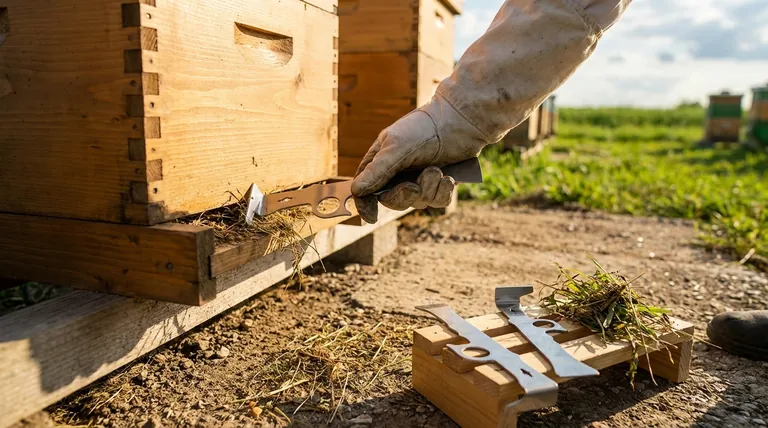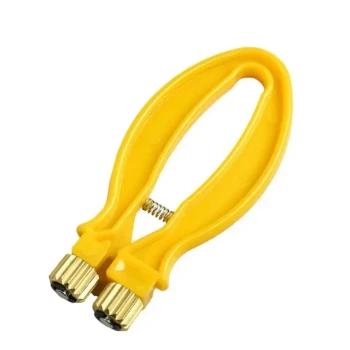As a general rule, the area directly under and around your beehives should be inspected and cleaned monthly during the warm season. This simple task is a crucial part of your routine hive maintenance and serves as a first line of defense against common threats to your colony's health.
The core principle is not just about tidiness; it's about creating a "defensible space" for your bees. A clean area under the hive eliminates hiding spots for pests and prevents moisture buildup, directly contributing to the long-term health and stability of the colony.

Why Under-Hive Maintenance is Critical
A well-kept area around the hive is not for aesthetics. It is a fundamental practice in Integrated Pest Management (IPM) and overall hive wellness.
Preventing Pest Invasions
Tall weeds and ground debris provide the perfect cover for pests. Pests like Small Hive Beetles, ants, and even rodents use this vegetation as a bridge to gain access to the hive entrance.
By keeping the area clear, you create an open zone that makes it harder for these invaders to approach the hive undetected.
Controlling Moisture Buildup
Overgrown vegetation traps dew and rainwater around the base of the hive. This constant moisture can seep into the bottom board, promoting mold, mildew, and wood rot.
A damp environment is unhealthy for bees and can weaken the hive's structural integrity over time.
Ensuring Proper Ventilation
Clear ground beneath the hive, especially if you use a screened bottom board, is essential for proper air circulation. Good ventilation helps the colony regulate its internal temperature and humidity more effectively, particularly during hot weather.
Adjusting Your Schedule Based on Local Conditions
While a monthly check is a solid baseline, you must adapt your frequency based on your specific environmental pressures. Blindly following a generic schedule is less effective than responding to your local conditions.
High-Risk Pest Areas
If you live in a region where pests like Small Hive Beetles or aggressive ant species are prevalent, you should increase your inspection frequency. A bi-weekly check during peak season is a wise precaution.
Wet or Humid Climates
In areas with high rainfall or humidity, vegetation grows faster and moisture is a constant threat. More frequent checks may be necessary to keep grass and weeds from touching the hive body and trapping dampness.
Low-Risk Arid Climates
In very dry climates with sandy soil and fewer ground-dwelling pests, a monthly inspection is typically more than sufficient. Your primary concern might shift from moisture to ensuring dry grasses do not become a fire hazard.
How to Apply This to Your Apiary
Your approach should align with your local environment and management goals. Use these guidelines to establish a routine that works for you.
- If your primary focus is proactive pest management: Inspect every two to three weeks and consider creating a permanent barrier like a gravel pad or paving stones under the hives.
- If you are in a moderate, temperate climate: A consistent monthly inspection and cleaning is the most reliable and efficient schedule.
- If your goal is to minimize routine labor: Establish a wide, permanent clear zone around your hives using weed barriers and mulch or gravel at the start of the season to drastically reduce ongoing maintenance.
This simple, regular maintenance is one of the most effective ways to support your colony's natural defenses.
Summary Table:
| Schedule | Key Focus | Best For |
|---|---|---|
| Monthly | General maintenance, pest monitoring | Moderate, temperate climates |
| Bi-Weekly | Proactive pest & moisture control | High-risk pest areas, humid climates |
| Seasonal Setup | Minimizing ongoing labor | All apiaries (gravel/mulch barrier) |
Protect Your Investment with Professional-Grade Equipment
A consistent maintenance routine is vital, but it starts with a strong foundation. Equip your commercial apiary or distribution business with durable, reliable supplies from HONESTBEE.
We provide wholesale-focused beekeeping equipment and supplies designed to withstand the elements and support healthy colonies season after season. From hive stands that improve ventilation to tools that make maintenance easier, our products are built for beekeepers who mean business.
Ready to build a more resilient and efficient operation?
Contact our wholesale team today to discuss your needs and discover how HONESTBEE can be your trusted partner in beekeeping success.
Visual Guide

Related Products
- HONESTBEE Advanced Ergonomic Stainless Steel Hive Tool for Beekeeping
- Multi-Function Hive Tool with Integrated Hammer for Beekeeping
- Wholesales Dadant Size Wooden Bee Hives for Beekeeping
- HONESTBEE Classic Pry Bar Hive Tool with High Visibility Finish for Beekeeping
- Professional Galvanized Hive Strap with Secure Locking Buckle for Beekeeping
People Also Ask
- What is a hive tool and what are its uses? Master Your Hive Inspections with the Essential Beekeeper's Tool
- How is a hive tool used for scraping and cleaning? Master Hive Maintenance for a Healthy Colony
- Why do hive tools have a hole? Unlock the Secret to Efficient Beekeeping
- Why is it important to compare the progress of different hives? A Beekeeper's Key Diagnostic Tool
- How should beekeepers handle bees when using a hive tool? Master Calm, Deliberate Techniques



















